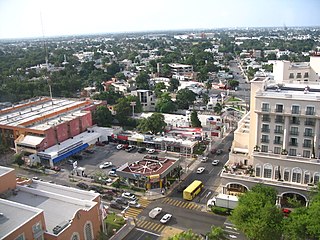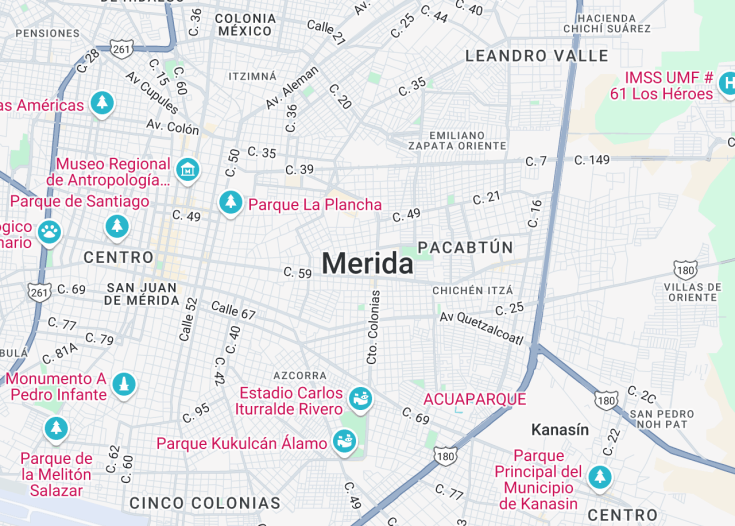Mérida, the vibrant capital of Yucatán, Mexico, is a city steeped in colonial history and rich Mayan heritage. Its well-preserved Centro Histórico, highlighted by the Plaza Grande and the opulent Mérida Cathedral, offers a glimpse into its storied past. Beyond its historical allure, Mérida captivates visitors with its lively cultural festivals, exquisite cuisine, and proximity to ancient Mayan ruins. Recognized as the cultural capital of the Yucatán Peninsula, it provides a beautiful blend of tradition and modernity, making it a compelling destination for travelers seeking a deeper understanding of Mexico’s past and present.
Before visiting Mérida, consider planning your trip during the autumn or winter months, when the weather is cooler and the city hosts numerous cultural events and festivals.
Make time to explore the Paseo de Montejo, Mérida’s grand boulevard, lined with historic mansions, museums, and cafés—it’s perfect for a leisurely afternoon stroll.
Top things to do & see in Merida
Select the following sights and activities to discover best tickets and tours available in Merida.
Merida: The White City
| Country | Mexico |
| Time in Merida | GMT-5 |
| Language spoken | Spanish |
| Population | 892,363 (INEGI 2020) |
| Currency | Mexican Peso (MXN $) |
| Airports | Manuel Crescencio Rejón International Airport (4.5 mi / 7.2 km). |
Merida, the capital of Yucatan State in Mexico, is a vibrant city rich in history and culture. Known as “The White City” because of its widespread use of white limestone and white painted buildings, Merida was founded in 1542 on the ruins of an ancient Maya city called T’ho. Today, it is a melting pot of Mayan and Spanish influences, reflected in its architecture, cuisine, and celebrations.
Merida is well-known for its colonial history, beautifully preserved in the form of mansions and buildings, particularly around Paseo de Montejo, a broad, tree-lined avenue modeled after the Champs-Élysées. Its historical significance extends to being a cultural hub, with numerous museums, art galleries, and daily cultural performances that make it a vital center for the arts. The city also serves as a base for visiting nearby Mayan archaeological sites such as Uxmal and Chichen Itza.
The climate in Merida is typically warm, with temperatures ranging from 20°C to 36°C throughout the year, which also makes it a destination for those looking to escape colder climates. Despite the heat, the city has a lively outdoor life at all times of the year, with markets, open-air cafes, and events that fill the plazas and streets.
Cuisine in Merida is another highlight, offering a unique blend of indigenous Mayan and colonial Spanish flavors. Dishes like cochinita pibil (slow-roasted pork) and panuchos (tortillas filled with beans and topped with turkey and vegetables) are local favorites. Visitors can explore the Lucas de Galvez market, a bustling center of local life with vendors selling everything from fresh produce to traditional Yucatecan meals.
For visitors, Merida provides a range of accommodations, from luxury hotels housed in old colonial buildings to comfortable mid-range options. With its warm, welcoming population, rich history, and pulsing cultural scene, Merida stands out as a must-visit destination in Mexico’s Yucatan Peninsula.
Where is Merida?
Merida is located in the northwest of the Yucatan Peninsula in Mexico, about 22 miles (35 kilometers) from the Gulf of Mexico coast.
Distances:
| Route | Distance by car | Time by car |
|---|---|---|
| Cancun to Merida | 196 mi (315 km) | Approx. 3 hours |
| Campeche to Merida | 103 mi (166 km) | Approx. 2 hours |
| Valladolid to Merida | 97 mi (156 km) | Approx. 1.5 hours |
What is Merida famous for?
Merida is famous for its rich colonial history and as a cultural heartland of Mexico, showcasing beautiful architecture, vibrant markets, and a deep-rooted Maya heritage.
History
Pre-Columbian Era
Long before Mérida was founded, the area was populated by the Maya civilization, who developed a sophisticated society with hieroglyphic writing, astronomy, arts, and architecture. The region was known as T’ho and was an important center in the northern Maya lowlands. Significant archaeological sites close to modern Mérida, such as Dzibilchaltún, serve as a testament to this rich pre-colonial heritage.
1542: Foundation of Mérida
Founded on January 6, 1542, by Francisco de Montejo “El Mozo,” Mérida was established atop the ruins of the Maya city of T’ho. It quickly became a focal point of Spanish colonial control in the Yucatán Peninsula. The city was organized around a central plaza with a grid system, characteristic of Spanish urban planning. Many of the stones from pre-existing Maya structures were used to build the city’s early colonial buildings, including the Mérida Cathedral.
19th Century: The Sisal Boom
The discovery of the commercial uses of henequén, also known as sisal, transformed Mérida during the 19th century. The city flourished economically as henequén plantations proliferated, bringing wealth and affluence. This period, known as the Green Gold era, saw the construction of many luxurious mansions and avenues, remnants of which are visible in Mérida’s Paseo de Montejo today.
20th Century Onwards
In the 20th century, Mérida continued to prosper and grow, adapting to the changing times while preserving its historical character. The city became a cultural and administrative hub in the region. In contemporary times, Mérida is known for its blend of colonial heritage and modern amenities, hosting a vibrant arts scene, cuisine, and festivals that celebrate its rich Maya and colonial past.
Visit Merida
What to see and do in Mérida, Mexico
From its colonial architecture to the vibrant cultural scene, Mérida offers a multitude of attractions:
- Explore the historic center, including the Mérida Cathedral and Casa de Montejo.
- Visit the Gran Museo del Mundo Maya to learn about the ancient Maya culture.
- Stroll along Paseo de Montejo for a glimpse of grandiose mansions from the sisal boom era.
- Experience the local cuisine by trying Yucatecan specialties like cochinita pibil and sopa de lima.
Festivals and Cultural Events in Mérida
Mérida hosts several annual events that reflect its rich cultural tapestry. Noteworthy among them is the Mérida Fest, which marks the city’s anniversary every January with concerts, art exhibits, and performances. The Yucatán Symphony Orchestra also offers regular seasons that enrich the city’s cultural life.
Best time to visit Mérida
The best time to visit Mérida is during the winter months from November to March, when the weather is cooler and more comfortable for exploring its many outdoor attractions.
Is Mérida worth visiting?
Mérida is most certainly worth visiting. With its rich history that merges Maya heritage with colonial architecture, vibrant cultural scene, and delicious cuisine, Mérida offers a comprehensive and unique experience that stands out in Mexico. Whether you’re a history enthusiast, a culture seeker, or a food lover, Mérida promises to provide something memorable for every kind of traveler.










